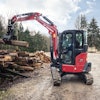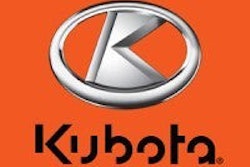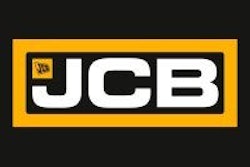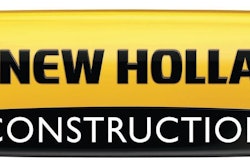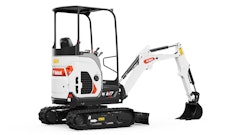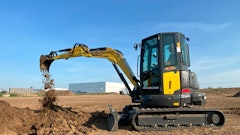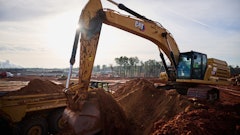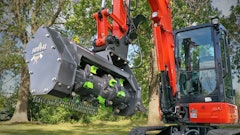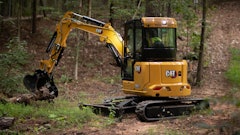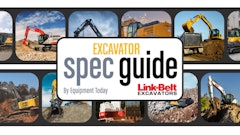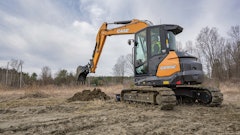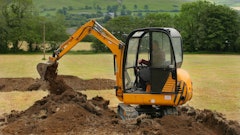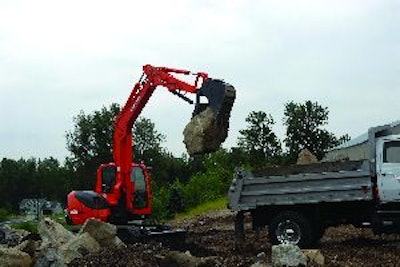
Dan Rafferty, compact product manager, JCB, recalls a saying his grandfather impressed upon him: "Use the right tool for the job." While it was made in reference to hand tools, Rafferty believes the same philosophy applies to selecting construction equipment. "It seems simplistic," he admits. "And it is cliché. But it's also the right advice."
Case in point: If you have to dig a 5-ft.-deep hole, you don't need an 18,000-lb. excavator to do it. "If what you're trying to do can be done with a smaller machine, then use it," he says.
With this concept in mind, mid-size (midi) compact excavators, weighing roughly 10,000 to 17,000 lbs., are making sense in a growing number of applications. These small, yet powerful machines are especially suited for contractors who may be growing their business and are seeking an excavator that can handle heavier tasks than the smaller models they currently own.
"Productivity is higher with these machines when compared to smaller models," says Keith Rohrbacker, product manager, Kubota Tractor Corp. "They offer more power through tough soil, and need to be repositioned less often. Plus, compared to larger models, they have a lower initial investment with lower operating costs. And they require smaller tow vehicles, so they are easier to transport between jobsites."
Mid-size models also tend to tread more lightly on finished surfaces. "The bigger and heavier the machine, the more it will disturb any existing turf and soil," notes Bill Gearhart, product manager, Yanmar America.
A balancing act
Mid-size compact excavators find frequent use in plumbing, electrical and sewage installations and maintenance, as well as site development/improvements and landscaping.
"Contractors use them for trenching smaller pipeline for residential water and electric lines," says Paul Golevicz, marketing brand manager, New Holland Construction. "They also use them near roads for culverts and embankments when doing drainage areas for developments. Underground work is really a great application for these machines."
In some areas of the country, they are popular with pool installers. "This size machine is a great choice for excavating pools when you need a machine to dig a little deeper with a little longer reach," says Rafferty. "You can't bring a 20-ton excavator into a backyard, and a small compact excavator doesn't have the reach you need. It's a balance."
This balance makes them well suited for tight sites requiring more power than a smaller compact can supply. "These mid-size models have plenty of power for tough soils and applications," says Rohrbacker. "They are stable enough to handle larger, more powerful and productive attachments when compared to smaller models. And larger machines are usually mono-boom, which makes them difficult to use along a wall or fence."
Several manufacturers also offer mid-size models in minimum and zero tailswing configurations, where the counterweight extends either minimally beyond the tracks or not at all. As a result, a 10,000-lb. unit with zero tailswing is able to get into the same areas as a 6,000-lb. machine, says Brian Rabe, product specialist, compact excavators and all-wheel-steer loaders, Gehl Co.
"You have so much more capacity and digging forces to go with that larger machine," he adds. "From that standpoint, depending on the machine's configuration, you can have a positive impact with a physically bigger machine."
The greater heft of mid-size machines also supplies added lifting power. "Flatwork contractors are able to lift up rocks," says Rafferty. "And landscapers doing specialty pools can bring in 500- or 600-lb. rocks and place them. On demolition projects, you can come in with a thumb, grab debris and load it into dump trucks. It gives you some dexterity, so you can be very productive."
And while smaller models likely have a dozer blade, its role on a mid-size machine becomes increasingly important. "We've found this is one of the major reasons why contractors buy this machine," says Golevicz. "If they're doing a small to moderate-size excavation around homes or for commercial construction, they can level off the ground with the dozer blade on the excavator, rather than bring in a separate dozer.
"It really comes down to sizing up the application and matching the machine to the job and the application," he continues. "Define your business practices and take the future into consideration."
Step up in features
As you step up in size, you typically step up in available features.
Many mid-size models offer more standard features than their smaller counterparts, especially when it comes to operator comfort. Roomier operator stations may be home to added creature comforts, such as adjustable suspension seats and armrests, as well as climate control options, hydraulic joysticks and operating pattern selectors.
A laundry list of production features can also be found in many models. Auto idle is one example.
"If the engine sits idle for more than four seconds, it will idle down to the designated rpm range to save fuel," explains Golevicz. "As soon as you move the joystick, the power that you receive is in direct proportion to the movement of the joystick. The operator is in full control of the hydraulic power of the machine."
Auto idle reduces noise levels and fuel costs. "With an excavator, you're moving all the time," Rabe comments. "If you're not, you're likely talking on the phone or to someone outside the cab. The engine will auto idle, so it is a little quieter; you can carry on a conversation. It also saves fuel. You don't want to be running full bore if you're not producing."
The availability of working modes also enhances performance. New Holland and Kobelco offer three working modes on their mid-size machines. The Heavy mode delivers full engine and hydraulic power for hogging out dirt, digging trench and lifting heavy rock. Standard mode runs at about 90% power for general digging and fuel savings. Fine control mode is suited for finish work.
The machines also have boom and arm anti-drift valves. "When you're swinging a load, this feature will help you stop quicker to prevent overswing," says Golevicz. "Also, when you're standing static with a load, it prevents the boom and arm from drifting for improved accuracy and increased cycle speed."
Proportional auxiliary hydraulics on JCB's mid-size models offer greater controllability. "Typically, with auxiliary hydraulics, it's push button on and off with full flow," says Rafferty. "If you're trying to control a thumb, you need more finesse to pick up a rock or a tree. You don't want it springing open, then slamming shut with the full flow of the auxiliary hydraulics. You want to feather it in and control it. That's what proportional auxiliary hydraulics can offer."
Attachment flexibility
The higher auxiliary hydraulic flows found on mid-size models enable use of more powerful and productive attachments compared to smaller compacts. Mechanical or hydraulic quick-attach options make them even more versatile.
"There are a lot of attachments that can be shared between these machines and skid-steer loaders," says Rabe. "We have an auger that can be mounted on a skid-steer loader or excavator with just a different pin kit. Another relatively common attachment is a hydraulic hammer that a contractor may also use for a wheel loader or skid-steer loader."
Rabe is also starting to see more requests for a standardized attachment system. This provides the ability to mount a breaker on a skid-steer loader or an excavator, eliminating the need for multiple attachments. "You may need to make some modifications," he states, "but at least you don't have to buy another $30,000 breaker."
Better Than a Backhoe-loader? "This is a growing weight class," he continues. "In general, the compact excavator group has been showing steady growth for the last five to six years, and this particular weight class has moved into the second largest growth class in compacts. That growth is coming from contractors who have bought into the compact excavator. It's a machine that is capable of doing tasks similar to a backhoe- or tractor-loader, but you can use it in conjunction with other equipment and be more productive." Actually, the mid-size compact excavator is often compared to a backhoe-loader, since a 10,000-lb. compact can do many of the same jobs, notes Rabe. "But you gain productivity and versatility in this size of machine," he says. "In many cases, you can dig faster because the machine is more mobile. The backhoe-loader needs to be planted. When you set it for digging, that's where it's positioned. You can't just swing the machine around to dump on the back side of you, or quickly move that machine forward." A compact excavator, on the other hand, has a 360° rotating house. "The machine can turn in its own circle and dig a square trench," notes Dan Rafferty, JCB. "If you're doing straight trenching with a backhoe-loader, you have a longer machine that you have to maneuver around. Flexibility of boom placement is another advantage. "With a kingpost-mounted backhoe, you can't get next to a house and dig straight down the side," Rafferty points out. "With our mid-size excavators, you can offset the boom and dig over the track. That feature has helped boost its popularity." On the other hand, the backhoe-loader is more practical when travel is required. "From a production standpoint, a mini-excavator will out-dig and out-trench a backhoe," Rafferty states. "But the backhoe becomes productive when you have one jobsite here and another one at the other end of a three-mile subdivision. A backhoe's travel speed is 18 to 20 mph. The travel speed for a compact excavator is about 3 mph." This is clearly an advantage when you need to move equipment longer distances. "The backhoe is self-sufficient. A contractor can drive it anywhere he needs it," says Rafferty. "With a compact excavator, you would have to trailer it to get to the other jobsite. Another advantage for the backhoe is that it has a front loader." |



